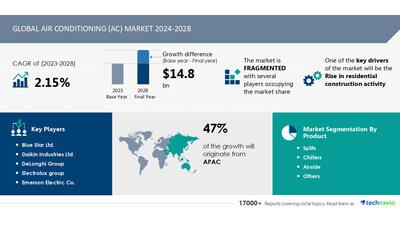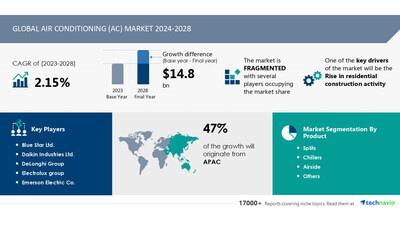Air Conditioning (AC) Market Size Is Set To Grow By USD 14.8 Billion From 2024-2028, Rise In Residential Construction Activity To Boost The Market Growth, Technavio
| Forecast period |
2024-2028 |
| Base Year |
2023 |
| Historic Data |
2018 - 2022 |
| Segment Covered |
Product (Splits, Chillers, Airside, and Others), Distribution Channel (Offline and Online), and Geography (APAC, Europe, North America, Middle East and Africa, and South America) |
| Region Covered |
APAC, Europe, North America, Middle East and Africa, and South America |
| Key companies profiled |
Blue Star Ltd., Daikin Industries Ltd., DeLonghi Group, Electrolux group, Emerson Electric Co., Fujitsu Ltd., Haier Smart Home Co. Ltd., Hitachi Ltd., Honeywell International Inc., Johnson Controls International Plc., LG Electronics Inc., MIDEA Group Co. Ltd., Mitsubishi Electric Corp., Panasonic Holdings Corp., Samsung Electronics Co. Ltd., Trane Technologies Plc, Transform Holdco LLC, Toshiba Corp., Voltas Ltd., and Whirlpool Corp. |
Key Market Trends Fueling Growth
Air conditioning (AC) systems utilize refrigerants, which are compounds capable of absorbing environmental heat and providing refrigeration or cooling when combined with components like compressors and evaporators. Vendors, including Daikin Industries and Samsung Electronics, employ various refrigerants, such as R-410A, R-32, and R-22, to meet cooling demands. R-32 refrigerant, with zero-ozone depletion potential (ODP) and low global warming potential (GWP), is gaining popularity due to its energy efficiency and reduced carbon emissions. R-32 ACs consume up to 10% less electricity than R-410A and R-22 models, making them an attractive choice for consumers. In March 2019, Samsung launched split ACs with R-32 refrigerant, offering higher efficiency and lower environmental impact. The increasing availability and adoption of R-32 ACs are expected to drive the global air conditioning market growth during the forecast period.
The AC market is thriving, with significant growth in both residential and commercial segments. Residential buildings are seeing increased demand for Room AC Windows, Split AC, and Smart Air Conditioners. In the commercial sector, businesses are investing in Centralized AC, VRF, Chillers, and Packaged Air Conditioners for Office Buildings, Retail Spaces, Healthcare Facilities, Data Centers, and Manufacturing Plants. Product launches and innovations, such as Inverter Technology and Energy Efficient designs, are driving the market forward. Mergers and acquisitions, collaborations, and partnerships are shaping the AC business landscape. Online Retail and Direct Sales are gaining popularity, while Distribution Sales continue to dominate. Global temperatures and urban heat are key factors driving demand. Automatic technology is replacing Manual technology for enhanced comfort and energy savings. The market is expected to grow further with the increasing focus on Energy Efficiency Standards.
Discover 360° analysis of this market. For complete information, schedule your consultation-
Book Here!
Market
Challenges
-
The air conditioning market is influenced by several factors that determine the price of appliances, including manufacturing costs, labor costs, and raw material prices. The cost of raw materials, such as steel, iron, plastic, glass, electronic equipment, petroleum products, and paints, significantly impacts the price of air conditioning products or the profit margins of manufacturers. Raw material prices are subject to change and can fluctuate based on international markets. Procurement of these materials involves additional costs like transportation and necessary services, supplier constraints, and inability to secure favorable arrangements for timely delivery. The prices of major raw materials like steel, rubber, iron, and plastic have seen significant volatility in the US and international markets. This price instability results in either increased product prices or reduced profit margins for manufacturers. The cost of petroleum products, which affect transportation costs for raw materials and final products, also influences market prices. Transportation costs include taxes, duties, and fuel prices, which can increase with rising crude oil prices. These factors challenge air conditioning market manufacturers to produce efficient and innovative hybrid air conditioners at competitive prices during the forecast period.
The AC market faces challenges in providing energy-efficient solutions for various sectors like residential buildings, office buildings, retail spaces, healthcare facilities, data centers, and manufacturing plants. Rising global temperatures and urban heat contribute to the increasing demand for air conditioning systems. Smart air conditioners, such as those with Inverter technology, are popular due to their energy efficiency. Energy Efficiency Standards are driving the industry to innovate with air conditioning units using non-inverter technology, window ACs, split ACs, multi-split ACs, and central ACs. Technological advancements, like NanoeX technology and smart technology, offer user comfort, improved indoor air quality, and air filtration systems for allergens and pollutants. Developing nations and urbanization require ecologically conscious goods, leading to the use of recycled materials and energy efficiency. Changing climate patterns necessitate the need for energy-efficient solutions, and commercial spaces are adopting these technologies to attract customers. Smartphones and user comfort further fuel the demand for air conditioners.
For more insights on driver and challenges
-
Download a Sample Report
Segment Overview
This air conditioning (ac) market report extensively covers market segmentation by
Product-
1.1 Splits
1.2 Chillers
1.3 Airside
1.4 Others
-
2.1 Offline
2.2 Online
-
3.1 APAC
3.2 Europe
3.3 North America
3.4 Middle East and Africa
3.5 South America
1.1 Splits-
The global air conditioning market is experiencing growth in the splits segment due to the increasing preference for energy-efficient and sleek split air conditioners. Vendors, such as Samsung, have ceased manufacturing window air conditioners and shifted production to split air conditioners to meet customer demand. Inverter-based split air conditioners are gaining popularity for their energy efficiency. The market has seen a decline in demand for ducted standard split air conditioners compared to non-ducted standard splits. Japanese-style mini-splits are becoming more popular in regions like North America as awareness grows. Refurbished products are driving demand for split air conditioners due to the increasing focus on energy efficiency and LEED certifications. Split air conditioners offer benefits such as easy installation, simultaneous heating and cooling effect, precise temperature control, and energy efficiency. They also make less noise and consume less energy than window air conditioners. These advantages have led to an increase in demand for split air conditioners, which will fuel the growth of the splits segment of the global air conditioning market during the forecast period.
For more information on market segmentation with geographical analysis including forecast (2024-2028) and historic data (2018 - 2022)
- Download a Sample Report
Learn and explore more about Technavio's in-depth research reports
The global HVAC Systems Market is experiencing robust growth, driven by rising urbanization, increasing demand for energy-efficient solutions, and advancements in smart technologies. The market is expanding across residential, commercial, and industrial sectors. Key players like Daikin, Carrier, and Johnson Controls are leading innovations in heating, ventilation, and air conditioning systems. The Asia-Pacific region dominates the market, fueled by rapid construction activities and government initiatives promoting green building standards.
Research Analysis
The AC business is thriving in today's world due to rising global temperatures and urban heat. Residential buildings, office buildings, retail spaces, and healthcare facilities are major consumers of air conditioners. Smart air conditioners, such as those with NanoeX technology and smart technology, are becoming increasingly popular for their energy efficiency and user comfort. Developing nations and urbanizing areas are witnessing significant growth in the AC market. Ecologically conscious goods, including air conditioners made from recycled materials, are gaining traction. Indoor air quality is a major concern, leading to the demand for air filtration systems that remove allergens and pollutants. Humidity levels are also a consideration, especially in tropical regions. Both residential and commercial segments are adopting advanced technologies like room AC windows, split AC, and energy-efficient solutions to maintain optimal indoor conditions. Smartphones and user-friendly interfaces are making it easier to control AC systems remotely.
Market Research Overview
The AC business is thriving in today's world due to rising global temperatures and urban heat. Residential buildings, office buildings, retail spaces, healthcare facilities, data centers, and manufacturing plants are major consumers of air conditioning systems. Smart technology and energy efficiency are key trends in the market, with smart air conditioners and inverter technology leading the way. Energy Efficiency Standards are driving the demand for energy-efficient designs and solutions. Air conditioning units come in various types, including window AC, split AC, multi-split AC, central AC, inverter, and non-inverter technology. Technological advancements, such as NanoeX technology, air filtration systems, and humidity control, enhance user comfort. Developing nations and urbanization are fueling the growth of the AC market. Changing climate patterns and the need for ecologically conscious goods are also influencing the industry. The market is witnessing numerous product launches, innovations, mergers and acquisitions, and collaborations and partnerships. Multi-brand stores, exclusive stores, and online stores are popular sales channels. The residential and commercial segments are the major consumers, with the commercial segment showing significant growth. Indoor air quality, allergens, pollutants, and humidity levels are key considerations for consumers. Smartphones and user comfort are also driving the demand for advanced AC features.
Table of Contents:
1 Executive Summary
2 Market Landscape
3 Market Sizing
4 Historic Market Size
5 Five Forces Analysis
6 Market Segmentation
-
Product
-
Splits
Chillers
Airside
Others
-
Offline
Online
-
APAC
Europe
North America
Middle East And Africa
South America
7 Customer Landscape
8 Geographic Landscape
9 Drivers, Challenges, and Trends
10 Company Landscape
11 Company Analysis
12 Appendix
About Technavio
Technavio is a leading global technology research and advisory company. Their research and analysis focuses on emerging market trends and provides actionable insights to help businesses identify market opportunities and develop effective strategies to optimize their market positions.
With over 500 specialized analysts, Technavio's report library consists of more than 17,000 reports and counting, covering 800 technologies, spanning across 50 countries. Their client base consists of enterprises of all sizes, including more than 100 Fortune 500 companies. This growing client base relies on Technavio's comprehensive coverage, extensive research, and actionable market insights to identify opportunities in existing and potential markets and assess their competitive positions within changing market scenarios.
Contacts
Technavio Research
Jesse Maida
Media & Marketing Executive
US: +1 844 364 1100
UK: +44 203 893 3200
Email:
[email protected]
Website:
SOURCE Technavio

Legal Disclaimer:
MENAFN provides the
information “as is” without warranty of any kind. We do not accept
any responsibility or liability for the accuracy, content, images,
videos, licenses, completeness, legality, or reliability of the information
contained in this article. If you have any complaints or copyright
issues related to this article, kindly contact the provider above.
Most popular stories
Market Research

- Latin America Mobile Payment Market To Hit USD 1,688.0 Billion By 2033
- Nutraceuticals Market Size Projected To Witness Strong Growth During 2025-2033
- BTCC Summer Festival 2025 Unites Japan's Web3 Community
- Meme Coin Little Pepe Raises Above $24M In Presale With Over 39,000 Holders
- Excellion Finance Launches MAX Yield: A Multi-Chain, Actively Managed Defi Strategy
- What Is The Growth Rate Of The Europe Baby Food And Infant Formula Market In 2025?























Comments
No comment